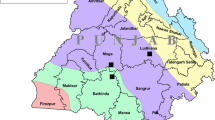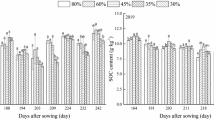Abstract
Estimation of spatial variability of soil organic carbon (SOC) content is important for agricultural management and environmental studies. In this study, geo-spatial prediction of SOC content was conducted to evaluate and compare geostatistical techniques of ordinary kriging (OK) and cokriging (CK) with hyperspectral satellite data (Hyperion) as an auxiliary variable. The study area located in western Uttar Pradesh, India. Hyperspectral satellite-derived spectral colour indices and spectral band reflectance used as auxiliary variables in CK. Spectral colour indices, viz. brightness index, coloration index, hue index and saturation index, were computed using atmospherically corrected Hyperion spectral bands reflectance data. Results of correlation analysis revealed that the spectral reflectance of Hyperion band 57 (1033.88 nm wavelength) has the highest correlation coefficient (r) with the SOC content (− 0.86) followed by brightness index (− 0.79), coloration index (− 0.78), hue index (− 0.77) and saturation index (− 0.66). Both spherical and exponential models best fitted the semivariograms with SOC and spectral reflectance of Hyperion band 57 and also with SOC and soil coloration index as auxiliary variables. Cross-validation results indicated that among the kriging methods, CK performed best using exponential semivariogram model and soil coloration index as auxiliary variable for spatial prediction of SOC content with highest R2 (0.653) and lowest RMSE (0.136%) values. In general, CK methods were superior to OK in spatial prediction of SOC content. A combination of cokriging geostatistical technique and remotely sensed hyperspectral data as auxiliary variables is very useful for improved and reliable spatial prediction of SOC content.












Similar content being viewed by others
References
Adamchuk, V. I., Hummel, J. W., Morgan, M. T., & Upadhyaya, S. K. (2004). On-the-go soil sensors for precision agriculture. Computers and Electronics in Agriculture, 44, 71–91. https://doi.org/10.1016/j.compag.2004.03.002
Awal, R., Safeeq, M., Abbas, F., Fares, A., Fares, S., Deb, S. K., Ahmad, A., & Fares, A. (2019). Soil physical properties spatial variability under long-term no-tillage corn. Agronomy, 9(11), 750–760. https://doi.org/10.3390/agronomy9110750
Bhunia, G. S., Shit, P. K., & Chattopadhyay, R. (2018). Assessment of spatial variability of soil properties using geostatistical approach of lateritic soil (West Bengal, India). Annals of Agrarian Science, 16(4), 436–444. https://doi.org/10.1016/j.aasci.2018.06.003
Bishop, T. F. A., & McBratney, A. B. (2001). A comparison of prediction methods for the creation of field-extent soil property maps. Geoderma, 103, 149–160.
Clark, R. N., Gallagher, A. J., & Swayze, G. A. (1990). Material absorption band depth mapping of imaging spectrometer data using a complete band shape least-squares fit with library reference spectra. In Proceedings of the 2nd Airborne Visible/Infrared Imaging Spectrometer (AVIRIS) Workshop (pp. 176–186). Pasadena, CA: JPL Pub. 90–54.
ENVI User’s Guide. (2006). Version 4.3.
Hengl, T., Heuvelink, G. B. M., & Stein, A. (2004). A generic framework for spatial prediction of soil variables based on regression-kriging. Geoderma, 120(1–2), 75–93. https://doi.org/10.1016/j.geoderma.2003.08.018
Khan, M. Z., Islam, M. A., Sadiqul, A. M., & Bhuiyan, M. M. R. (2019). Spatial variability and geostatistical analysis of selected soil. Bangladesh Journal of Scientific and Industrial Research, 54(1), 55–66.
Kumar, N., Velmurugan, A., Hamm, N. A. S., & Dadhwal, V. K. (2018). Geospatial mapping of soil organic carbon using regression kriging and remote sensing. Journal of the Indian Society of Remote Sensing, 46(5), 705–716. https://doi.org/10.1007/s12524-017-0738-y
López-Granados, F., Jurado-Expósito, M., Peña-Barragán, J. M., & García-Torres, L. (2005). Using geostatistical and remote sensing approaches for mapping soil properties. European Journal of Agronomy, 23, 279–289.
Mallik, S., Bhowmik, T., Mishra, U., & Paul, N. (2020). Mapping and prediction of soil organic carbon by an advanced geostatistical technique using remote sensing and terrain data. Geocarto International, 10, 115. https://doi.org/10.1080/10106049.2020.1815864
Mandal, U. K. (2016). Spectral color indices based geospatial modeling of soil organic matter in Chitwan district, Nepal. The International Archives of the Photogrammetry, Remote Sensing and Spatial Information Sciences, XLI-B2, 43–48.
Mathieu, R., & Pouget, M. (1998). Relationships between satellite-based radiometric indices simulated using laboratory reflectance data and typic soil colour of an arid environment. Remote Sensing of Environment, 66, 17–28. https://doi.org/10.1016/S0034-4257(98)00030-3
McBratney, A. B., Mendonc, M. L., Santos, A., & Minasny, B. (2003). On digital soil mapping. Geoderma, 117, 3–52. https://doi.org/10.1016/S0016-7061(03)00223-4
Mirzaee, S., Ghorbani-Dashtaki, S., Mohammadi, J., Asadi, H., & Asadzadeh, F. (2016). Spatial variability of soil organic matter using remote sensing data. CATENA, 145, 118–127.
Nelson, D.W., & Sommer, L. E. (1982). Total carbon, organic carbon and organic matter. In Methods of soil analysis, part 2, chemical and microbiological properties, 2nd edition, ASA-SSSA, Madison, 595–579.
Reza, S. K., Utpal, B., Sarkar, D., & Singh, S. K. (2016). Spatial variability of soil properties using geostatistical method: A case study of lower Brahmaputra plains, India. Arab Journal of Geosciences, 9(446), 2–8.
Vasques, G. M., Grunwald, S., & Sickman, J. O. (2008). Comparison of multivariate methods for inferential modeling of soil carbon using visible/near-infrared spectra. Geoderma, 146, 14–25. https://doi.org/10.1016/j.geoderma.2008.04.007
Wang, J., Yang, R., & Bai, Z. (2015). Spatial variability and sampling optimization of soil organic carbon and total nitrogen for Minesoils of the Loess Plateau using geostatistics. Ecological Engineering 82, 159–164.
Webster, R., Oliver, M., (2001). Local estimation or prediction: kriging. In: Geostatistics for environmental scientists (pp. 149–191). England: Wiley.
Wu, C., Wu, J., Luo, Y., Zhang, L., & DeGloria, S. D. (2009). Spatial Prediction of soil organic matter content using cokriging with remotely sensed data. Soil Science Society of American Journal, 73(4), 1202–1208.
Yan, P., Peng, H., Luobin, Y., & Lin, K. (2021). Spatial variability of soil physical properties based on GIS and Geo-statistical methods in the red beds of the Nanxian basin, China. Polish Journal of Environmental Sciences, 28(4), 2961–2972. https://doi.org/10.15244/pjoes/92245
Acknowledgements
The authors would like to acknowledge Indian Institute of Remote Sensing (IIRS), ISRO, Dehradun, for the supports provided for field data collection, soil physical and chemical analysis, and satellite data processing. First author is especially thankful to Dean, School of Engineering and Head, Department of Petroleum Engineering and Earth Sciences, University of Petroleum and Energy Studies, for their encouragement and support in the preparation of this research article. Special thanks to two anonymous reviewers for their valuable suggestions for improving the quality of the research article.
Funding
None.
Author information
Authors and Affiliations
Corresponding author
Ethics declarations
Conflict of interest
The authors declare that they have no conflict of interest.
Additional information
Publisher's Note
Springer Nature remains neutral with regard to jurisdictional claims in published maps and institutional affiliations.
About this article
Cite this article
Saha, S.K., Tiwari, S.K. & Kumar, S. Integrated Use of Hyperspectral Remote Sensing and Geostatistics in Spatial Prediction of Soil Organic Carbon Content. J Indian Soc Remote Sens 50, 129–141 (2022). https://doi.org/10.1007/s12524-021-01459-7
Received:
Accepted:
Published:
Issue Date:
DOI: https://doi.org/10.1007/s12524-021-01459-7




